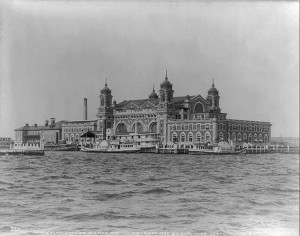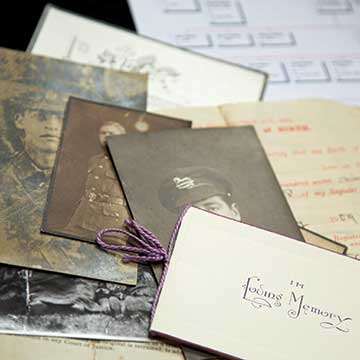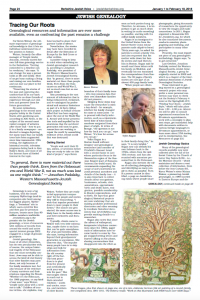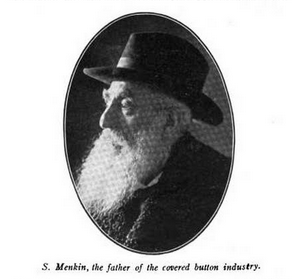
In 1905, a young man and his pregnant wife sailed from Glasgow to New York, after escaping from Russia during a period of intense pogrom activity. When the ship landed in New York, the young man was most anxious to get his wife safely settled for the child’s birth and to join his three older brothers who had already arrived and started their new life in America.
The ship record was my first clue that something had gone wrong when the couple reached Ellis Island. In the far right hand margin of the passenger list, there was a handwritten note regarding the young man’s medical condition, “barber’s itch” and in the far left-hand margin, the letters “SI” (Special Inquiry) appeared and the word “deported” had been ink-stamped. Their names also appeared on a separate “Record of Detained Passenger” with the notations, “Hold on Appeal” and “Appeal dismissed, ordered deported.”
Barber’s itch was the name of a highly contagious condition, and when diagnosed by one of the medical examiners at Ellis Island, was one of the diseases that resulted in the barring of immigrants from approval to enter the U.S.
What happened between their landing at Ellis Island, full of hope, and their deportation? First, they would have been held for a special inquiry in a room with other immigrants awaiting determination. Approximately 20% of immigrants to the U.S. would be held for some length of time. Stories about this interim detention vary widely. Some immigrants have reported that they were held in clean, sanitary rooms and were humanely treated. Others report that they were detained in cramped areas with poor ventilation. Regardless of their experience while waiting for approval to enter, 2% would be refused admission. Immigrants who were held aside were brought before a Board of Special Inquiry, which heard each case privately. An interpreter was usually present and witnesses were allowed. (Island of Hope, Island of Tears, by David Brownstone, Irene Franck and Douglass Brownstone; Barnes and Noble, New York, NY: 2000; 213).
During this particular hearing, the couple gave testimony and one of his brothers arrived to testify for him. Since the couple did not arrive with extra funds, the Board of Special Inquiry pronounced the couple a “likely public charge” meaning that they did not have the means to support themselves, which also contributed to the final determination to deport them.
I had imagined this hearing to take place in a large courtroom. The actual hearing room, I discovered, was much smaller than I visualized. As I stood at the door and peered into the hearing room (access into the room was not available), I thought about how afraid this young man would be, how worried he would be for both of them. I thought about the young woman, worried for her husband and the child she carried. It was a sad scene I could feel, even from the distance of one hundred and ten years.
After the decision was made to deport them, an appeal was filed to the Commissioner-General of Immigration in Washington, D.C.
During the appeal, testimony was supplied indicating that the young man had a temporary condition resulting from being shaved under unsanitary conditions, or if it was Barber’s Itch, it was a very mild case that could improve in two to three weeks. The relatives, it was promised, were willing to pay for the medical treatment while the couple was detained. The young man was described as being skillful at his trade and fully capable to support himself and his wife (refuting the label “likely public charge”).
Their case was carefully reviewed and the couple questioned again while remaining in the detention quarters. In spite of the prospects for a successful immigration, due to the medical condition and the commission’s belief that they would not be able to make it financially, it was recommended that the Board of Inquiry decision be affirmed and that the appellants be deported.
As a genealogist and family historian, I wanted to know if it was possible to get a copy of the appeal transcript. With guidance from Marian L. Smith, Senior Historian at the U.S. Citizenship and Immigration Service (USCIS), I sent an inquiry to the National Archives in Washington, D.C. for a search in Record Group 85, which contains immigration correspondence files. The USCIS website at www.uscis.gov provides a description of the records in Record Group 85.
The National Archives returned a fascinating document of the hearing and appeal that included responses to questions by the immigrant couple, testimony of the brother who appeared, and the text of the decision by the Commissioner to deport. Valuable genealogical information was included in the content of the file revealing clues for further search on the older brother who testified and necessary information to follow the couple after their deportation.
Our National Archives hold treasure after treasure, in this case, a document that allowed us to time-travel.
Wondering what happened to the young couple? Even better, contact me if I can help you to look into your own family history for poignant stories, historical documents and a new understanding about the present from the past.
Ellis Island in 1905; photo by A. Coeffler (Library of Congress)
 Digging into your family’s history is a very personal journey.
Digging into your family’s history is a very personal journey. My work was featured in the January 2018 issue of Berkshire Jewish Voice.
My work was featured in the January 2018 issue of Berkshire Jewish Voice. Solomon and Hannah Menkin moved to America in 1888. Tracking them after that gets a little tricky.
Solomon and Hannah Menkin moved to America in 1888. Tracking them after that gets a little tricky.

